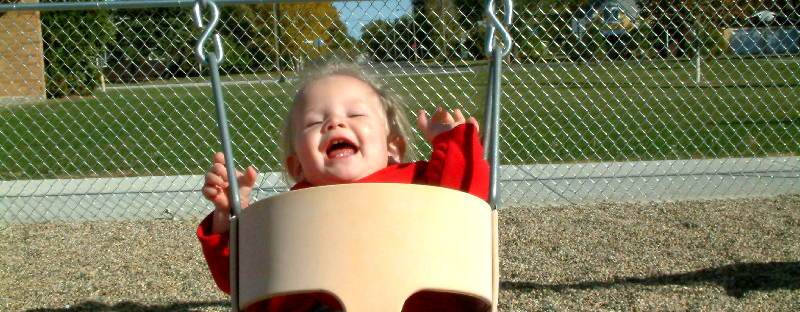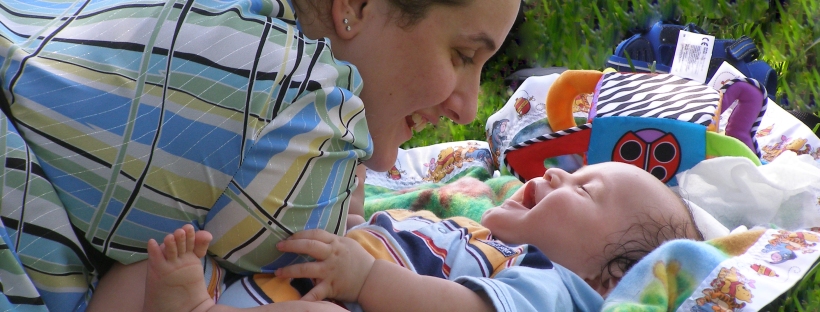Another way to get her comfortable in the tummy position is to carry her around with her tummy rested on the inside of your forearm. It isn’t as rigorous of practice compared to when she is doing tummy time on a flat surface, but it is a great way to transition into that position eventually. Make sure to do both arms so she gets to practice balance on both sides. Aim to carry her in this position for at least 15 min. This will count as 1 round of your 4 daily sessions of tummy time. Feel free to repeat this exercise. Also, It’s a good bicep workout for the person carrying.
Category: 3-6A
Pillow or Exercise Ball Tummy Time
This session will count as 1 round of your 3-4 daily sessions of tummy time. Feel free to repeat this exercise. Using an exercise ball or pillow will allow you to vary the degree of incline for her in tummy time. The exercise ball is angled everywhere since it is round. Place her not on top, but on the top side of the ball so that her head is at the top of the incline. Support her with your hand on her back. If using a pillow, put her chest at the edge of the pillow so she is propped up. Make sure your pillow is wide enough for her to place her hands on the pillow as well. Very the incline based on her comfort. A baby new or frustrated with tummy time may want a higher angle similar to that when you hold baby on your shoulder. Eventually, we want her to be able to tolerate the more challenging position, which is on the top of the ball or pillow, for longer periods of time. When using the ball, practice safety and be aware that it rolls.
If she is very young and this is her first exposure to tummy time, you can pick her up a few minutes (or seconds) into fussing. Then increase goal to 5 min next time, then 7min, 10min, 12min, and 15min. Your goal is to get to at least 20min of tummy time 4 times a day or 25min of tummy time 3 times a day. Make sure to pick a time of day she is alert, calm, and willing. Don’t worry. With more practice in these comfy positions while slowing increasing her tolerance, she’ll be able to do classic tummy time on the floor in no time.
Tummy Time
Place baby gently on her tummy. Make sure the surface is not too soft or hard. A blanket or play mat covering the ground is a good tummy time spot. Of course, always be next to her. Talk to her and give encouraging, comforting words. She most likely will not like tummy time at first and will fuss. That’s OK! Try for at least 5 min in the beginning, and if she isn’t having it, go ahead and end early. Slowly increase her tummy time. If she is still fussy, increase time before picking her up by 2 min every other day. If she is not fussy, let her play until she gets bored. A pro at Tummy Time? Keep engaging her through face to face interaction, words, and toys to help her practice raising her head, chest, and eventually lift with her arms. Goal of tummy time is at least 25min three times a day.
Label Play Baby Activities
Starting from as early as 3 months.
Begin to label objects, people, and actions that she is looking at. This will give her an idea of nouns and verbs. For instance, if she is looking at a dog, say: “Oh, there is a dog! That is a dog.” Or, if the dog is running, you can say: “Look, the dog is running! He is running so fast.”
WHY? William Fowler, an educational psychologist, developed a program that emphasizes how and when to speak to babies. The essence of his program is to introduce language development stages before the baby has exhibited meeting each stage. He studied the program’s effectiveness on 30 children and found: first words spoken between 7-9 months; some spoke sentences at 10 months; and most became proficient in basic rules of grammar by the age of 2 years old. These basic language milestones were achieved several months ahead, and in the case of grammar, achieved it a whooping 2 years ahead when compared to babies in normal environments.
Early and Often Baby Activities
Parentese, which is how most people naturally want to speak to babies and toddlers, is higher pitched overall with wide swings in pitch when spoken. This gives parentese its singsong quality. Along with its high intonation(variations in pitch) characteristics, parentese allows for babies to pick up different speech patterns as well as distinct words, vowels, and syllables.
Parents all over the world speak in parentese, regardless of the language spoken. Let your natural instinct and voice come out as you talk with your child. Remember, communicating early and often is the best recipe for language development!
Parentese
The sing-song voice we naturally want to speak with babies and small children is called parentese. And, wouldn’t you know, this natural instinct has been shown to be preferred by babies. It is a great vehicle for children to pick up speech and speech patterns.
If you have been talking parentese to your little one already- great! Keep it up, and aim to pick 3 times today when you find you are not talking to your little one. Stop what you’re doing and converse with her. If you haven’t been using parentese or feel foolish for doing so, now is the time to start. This is the best way for babies to pick up language. Spread the word about the impact parentese has on a child’s language development. Aim to speak to your baby in parentese today.
Richness in Sound Baby Activity
Give her a rich experience of sound! Take her for a walk outside where many of her senses will be engaged! She can feel the breeze and warmth of the sun on her skin, she can hear the world of sounds outside, and she can feel her body in motion. Aim to walk at least 15-30min.
Balance and Motion Infant Activity
Our vestibular system is a sensory system to help us with balance, position, and motion. When this sense is stimulated in babies (usually by some form of movement), it not only helps their sensory abilities develop, but also helps their motor abilities and early brain development overall. As you have probably already discovered when you trigger it, the added benefit is that it is comforting to your baby! Here are ways to stimulate the vestibular system:
- Sit in a comfortable seat and lay your baby on your lap. Sway and rock your baby rhythmically and gently from side to side. Talk or sing to her.
- Rock, jiggle, swing, bounce, and carry your baby around. Even putting her in a sitting position (make sure she is developmentally ready) or propped up on pillows is a different position compared to what she’s usually in and will stimulate her vestibular system.
As always, practice safety. Do not do rigorous movements. Make sure your baby’s head is stabilized either by you or by themselves if they are strong enough.
Language & Turn Taking Baby Activity
Have a conversation with your baby, face-to-face! Let him learn the patterns of conversation through turn taking. You say something, maybe ending with a question, and then pause to let him have a chance to “say” something. All that babbling is him talking to you! Even if he isn’t babbling back yet, still pause before talking again. Engage in conversation as long as he is interested- aim for 10-15minutes. Soon, you’ll be amazed how quickly he understands turn taking! He will just love spending quality, focused time with you just talking!








